Weeks ago I reported exclusively that American Airlines was planning a ‘pivot to premium’ with CEO Robert Isom telling colleagues that they would have a “rededication and a renewal to focus on the customer experience” and that this would be “the next order of business, we’re going to organize around this.”
The game’s getting harder. People expect more. But it’s not just expecting more. They’re willing to engage with us and pay more for premium services.
The carrier appointed a Chief Customer Officer and a new Customer Experience Unit, as well as a new head of the AAdvantage program. There have been broader re-organizations within the company as well.
Detailing new leadership and reporting structures, airline Vice Chair and Chief Strategy Officer Steve Johnson wrote to employees:
It is abundantly clear the competitive battleground in the network airline business has, like never before, shifted sharply to product and customer service. As our ability to outperform in revenue will depend increasingly on embracing that reality and delivering a different and elevated customer experience, especially for our premium and lost loyal customers.
For years I’ve written that American Airlines has high costs, and can’t win with a strategy of aping Spirit and Frontier (despite that having been Isom’s focus while President of the airline). Over the past three years they’ve been focused primarily on costs when they largely have a revenue problem. They need to earn a revenue premium because saving an incremental $100 million through purchasing efficiencies and product cuts doesn’t move the needle, and can be more than offset in revenue losses.
They seem to be realizing this. American continues to speak to what readers of this website have known about for weeks: an intention to move into premium.
American Has Several Premium Initiatives Underway
American Airlines is putting new business class suites into Boeing 787-9 aircraft when new ones come from Boeing. They plan to eliminating first class and put these business class suites onto Boeing 777-300ER aircraft as well. However, there is no announced plan to retrofit existing aircraft with this business class product. There will be Boeing 787-8s and -9s with old business class (indeed, two different legacy business class seats) as well as -9s with new suites.
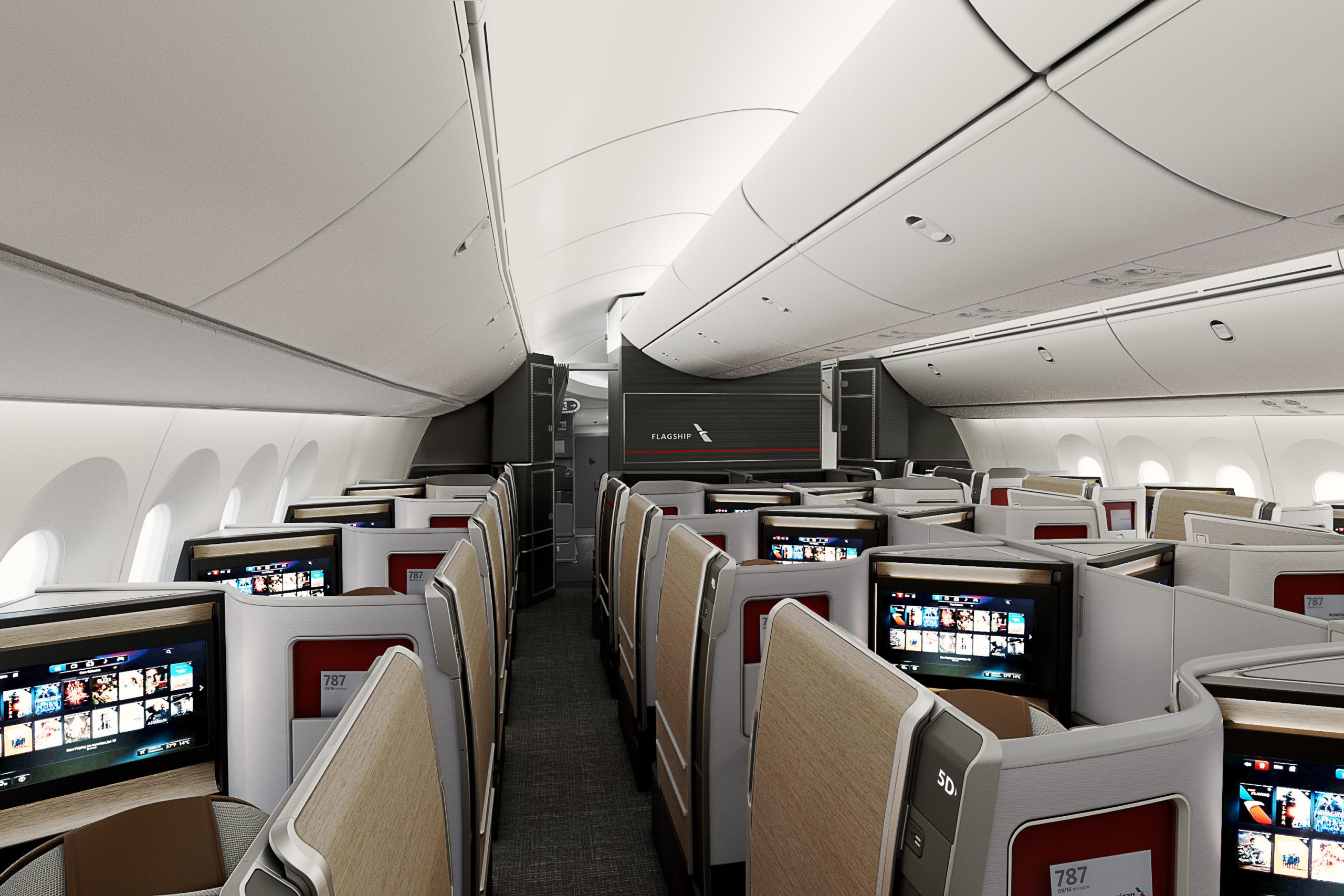
Credit: American Airlines
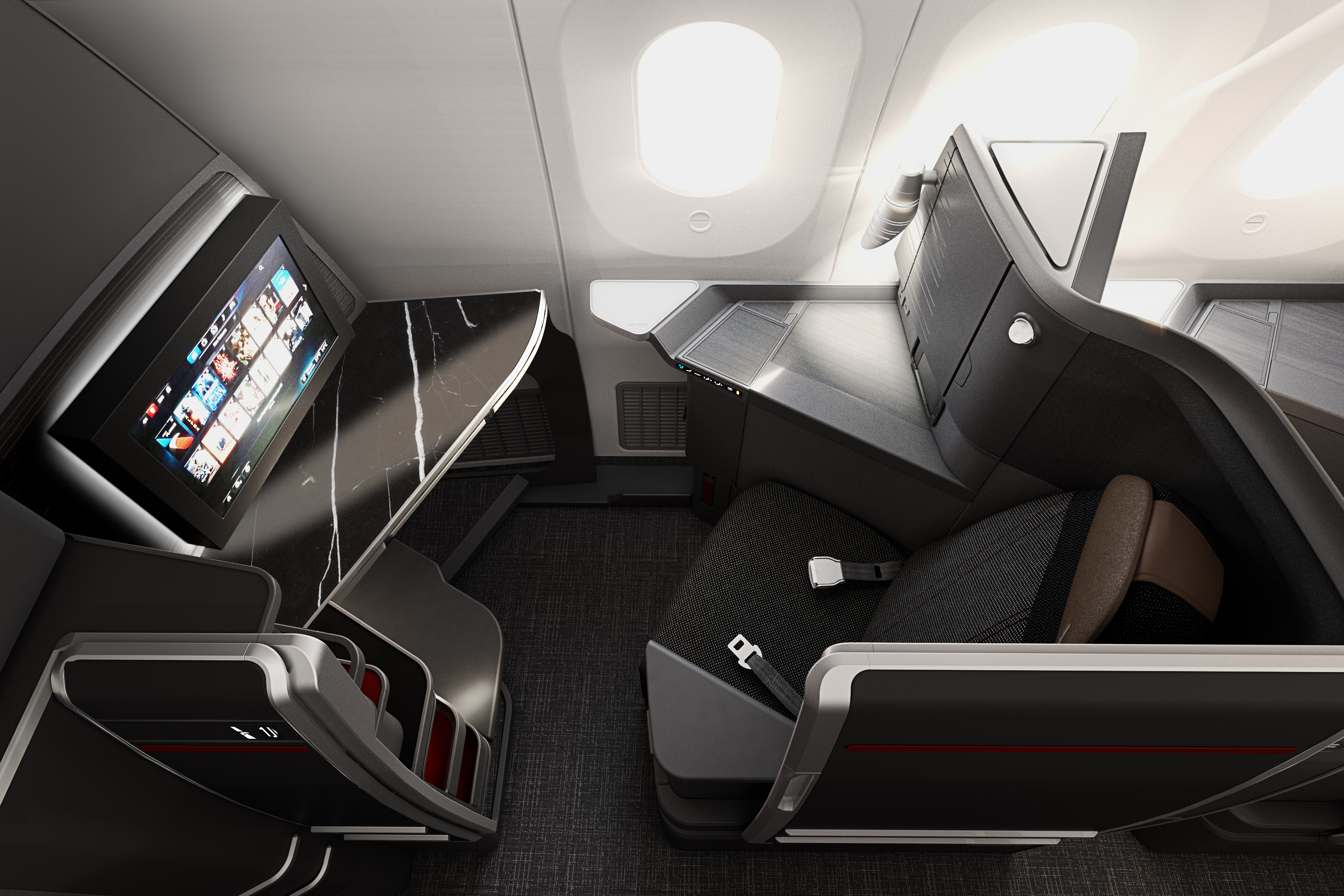
Credit: American Airlines
American is also putting business suites into narrowbody Airbus A321XLRs which will fly cross-country in premium markets like New York JFK – Los Angeles, and on shorter transatlantic routes from New York and Philadelphia.
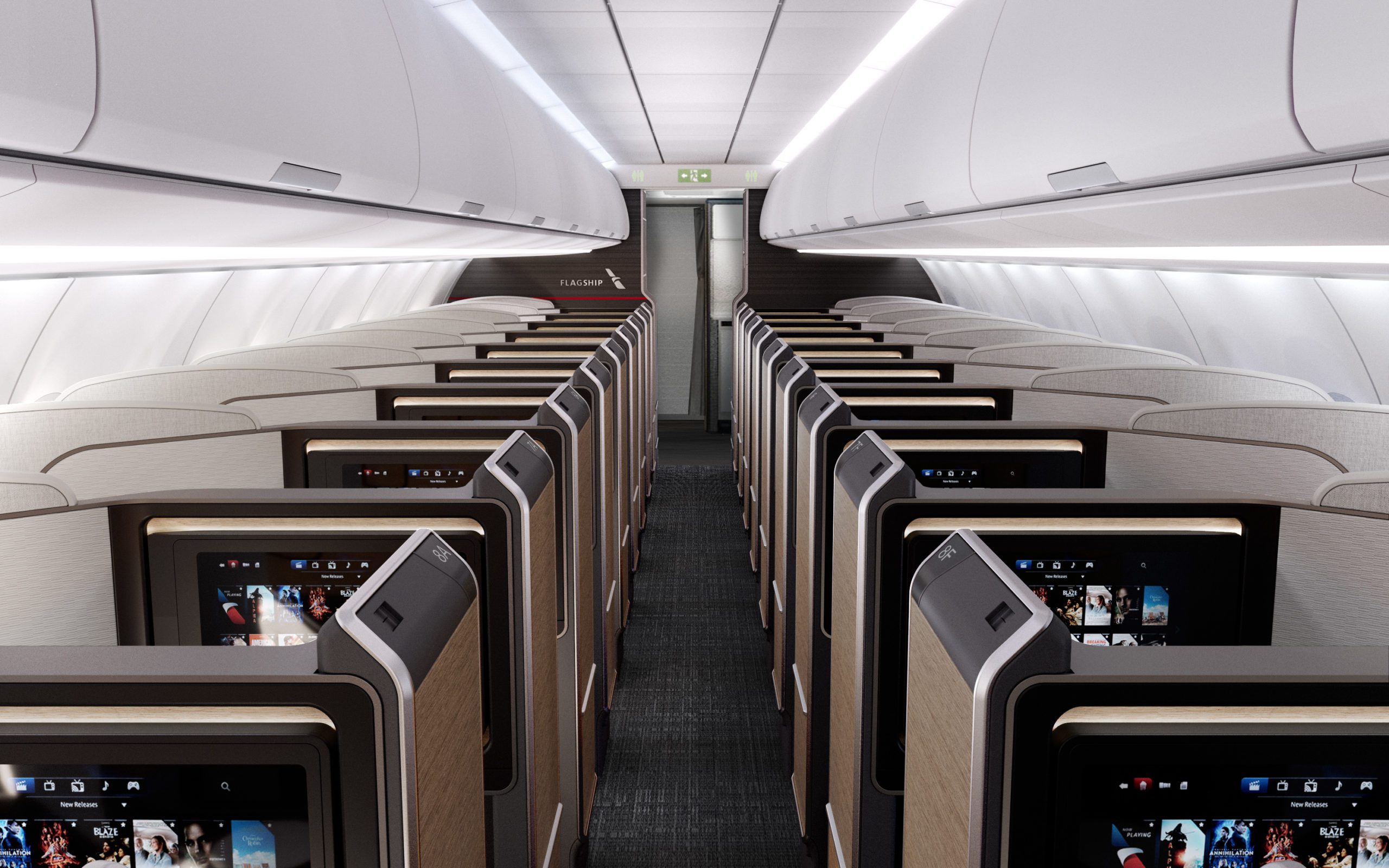
Credit: American Airlines
They are adding first class seats to domestic Airbus A319s and Airbus A320s. They are adding high speed wifi to regional jets. And they’re finally planning to open a business class lounge at their primary transatlantic gateway of Philadelphia.
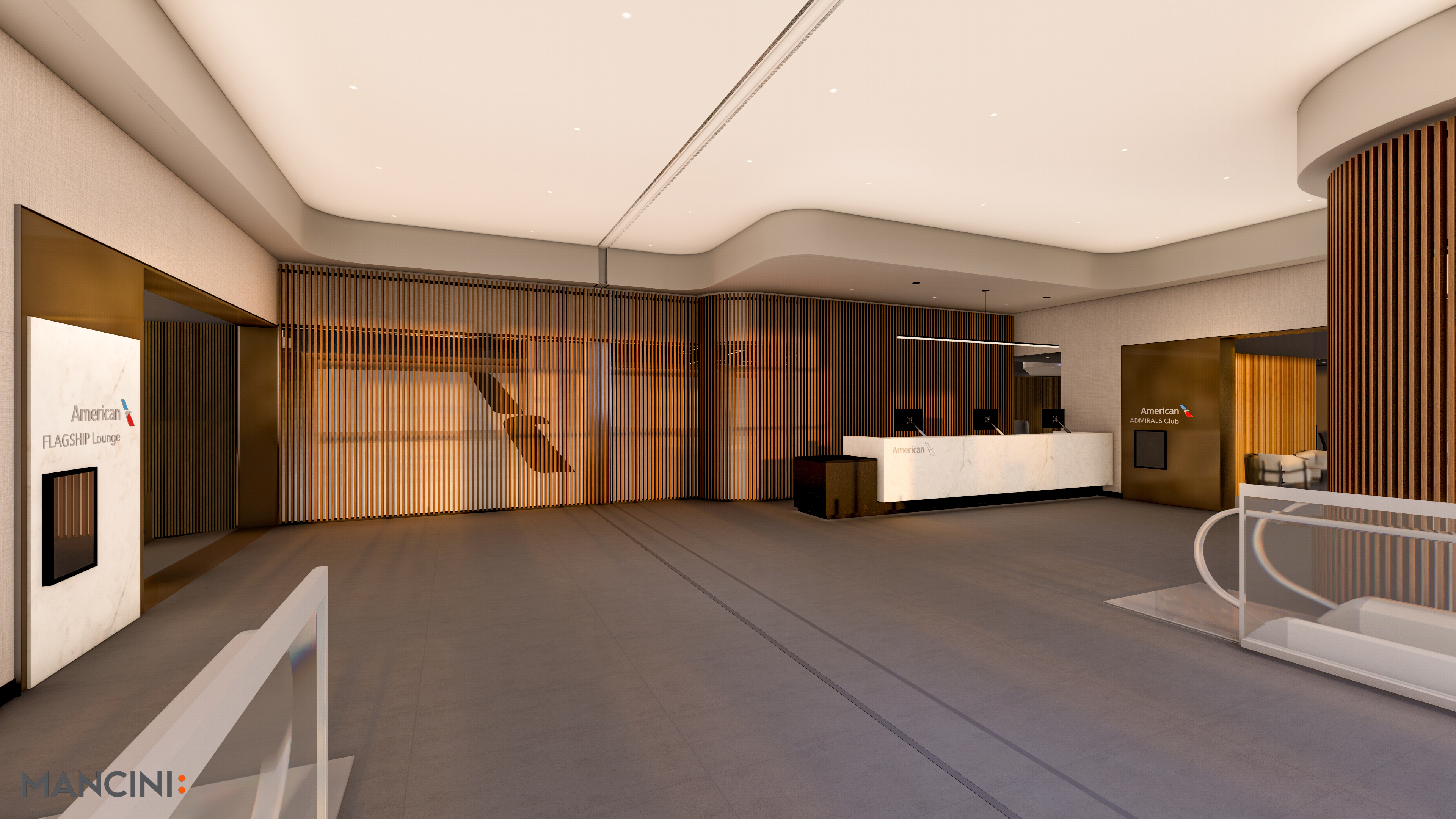
Philadelphia Flagship, Credit: American Airlines
However, they also plan to rip out seat back entertainment screens from remaining Airbus A319s that still have them, as well as from Airbus A321T premium cross-country planes in order to match current interiors.
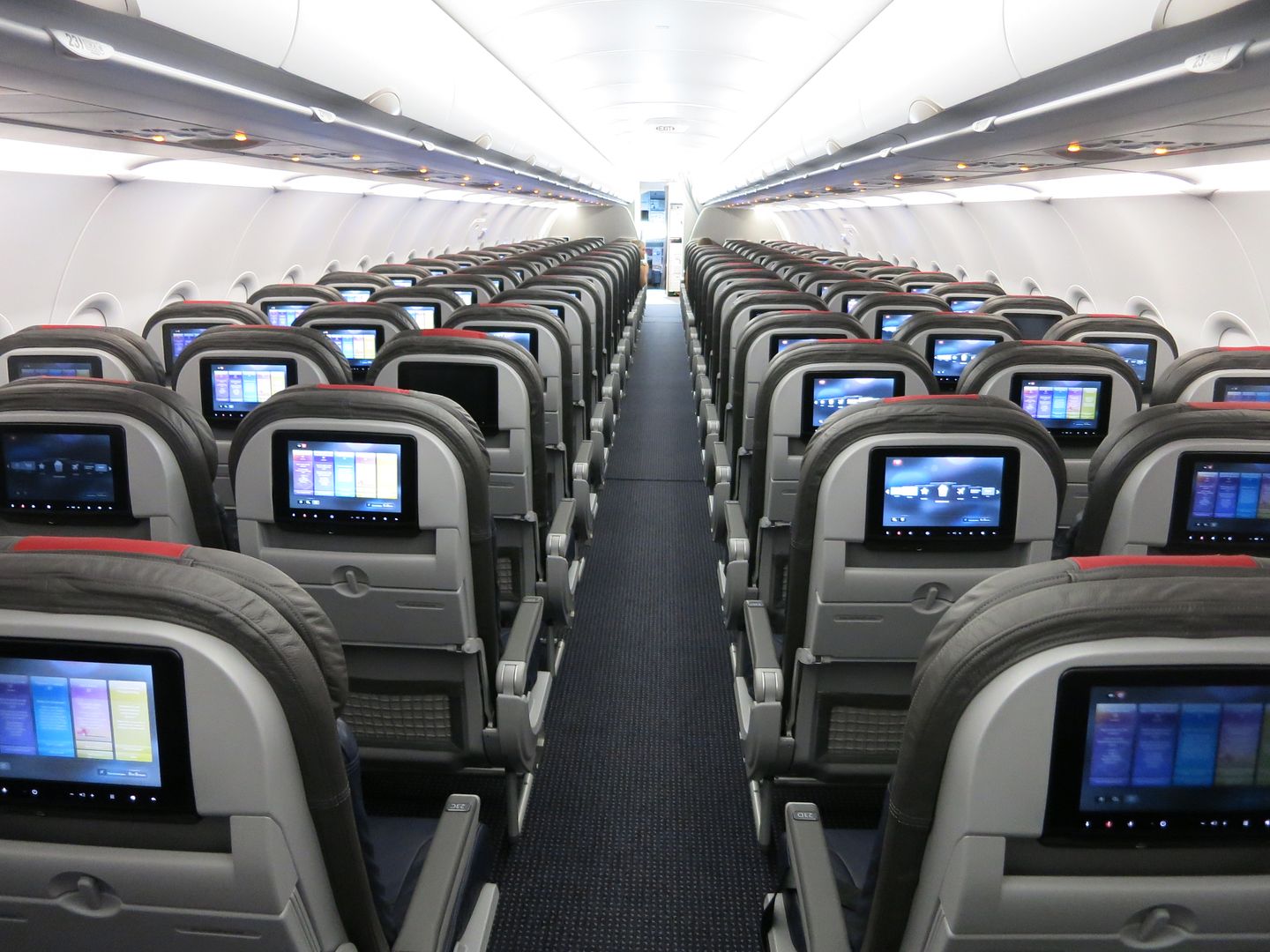
Legacy American Airlines Airbus A319 Interior
There’s No Premium Culture At The Airline
American doesn’t have enough premium seats to sell today, because they spent years ripping business class seats out of planes. They don’t have enough extra legroom seats to sell, because they spent years ripping those out too at the same time they were removing seat back televisions. They charge more for wifi than any other airline. They barely sell food in coach. Their lounges have less food than Delta’s and United’s, and food that isn’t as good as Delta’s. The products in their premium economy amenity kits are nearly identical to what they offer in business class and Flagship first class. They use the same contents!


In other words, they’ve spent years chopping the product – in Isom’s words ‘not spending a dollar they do not need to’ – and that’s not only meant a cheaper product but also a culture where paying attention to the small touches of product is not rewarded. Getting the pairing of just the right entree and starter, or ensuring that the right wines accompany meals, isn’t how middle managers get ahead at the airline (indeed, they outsourced wine selection to Intervine – handed them a budget to hit rather than worrying about what was supplied).
Premium is about more than how much you spend – although budget certainly matters – it’s about careful about every detail in execution. It’s not just about having seats, but the details and stitching of the seats. It’s not just about having meals, or how much you spend on the meals, but sweating the details to get the most out of every dollar.
Since US Airways management took over at American that’s not something which has been instilled in the culture, and since ex-Northwest managers gained prominence that’s been further exacerbated. They have a ‘wartime on costs consigliere’ in their current CFO. It’s hard to see how real change happens.
Premium Isn’t Just About Premium Cabins
Most passengers don’t fly first class. They sit in coach. Several years ago Delta was offering hot towels, welcome drinks, and course-based meals in long haul economy. That’s actually premium. Singapore Airlines economy seats have foot bars and cup holders, not just seat back entertainment screens and greater legroom.
Coach seats with padding and details from stitching to screens and robust buy on board meals along with free wifi are table stakes for an airline that’s positioning itself as premium.
United has stroopwafels and Illy coffee, those were symbols of a new era when Oscar Munoz took over – jettisoning the Fresh Brew coffee loathed by customers, that American still uses. Munoz traveled their system, talking to employees, convincing the front line that the airline had a bright future. He worked to turn around employee sentiment. Delta employees are genuinely product of their product, and the infectiousness shows in customer interactions. Premium isn’t just products, it’s attitudes.
There’s less money to spend on economy passengers but that doesn’t mean any less of an effort to invest in premium across all cabins of the aircraft and customer segments.
Is it any surprise, though, that in 2018 – when American invested more in coach than today – the airline served knockoff Stroopwafels that weren’t as good? “Rip Van Wafels.” Even those are gone.
What We’re Likely To See
American is likely to tout premium product changes that have been underway for years as new. But business suites that I wrote about in 2020, and satellite wifi driven by the expected end of life of the air to ground network, aren’t part of a new premium orientation.
When the airline announced that they would raise the annual fee for lounge membership, and that the annual fee on their Citibank co-brand credit card that comes with lounge, they announced better food was coming. We’ve seen them copy Delta and United and offering more food, but it’s a ‘me too, but less than’ approach. That’s what they’ve done for many years – monitoring the competition, getting forced into making investments, and doing just a little bit less than others.
American’s Flagship business class lounges aren’t as nice as United Polaris or Delta One lounges. They haven’t re-opened Flagship First Dining in Los Angeles. Now that they have a path for customers to redeem miles for access they should – if only to symbolize and highlight what they can deliver in the premium space, in one of the most premium markets in the country.
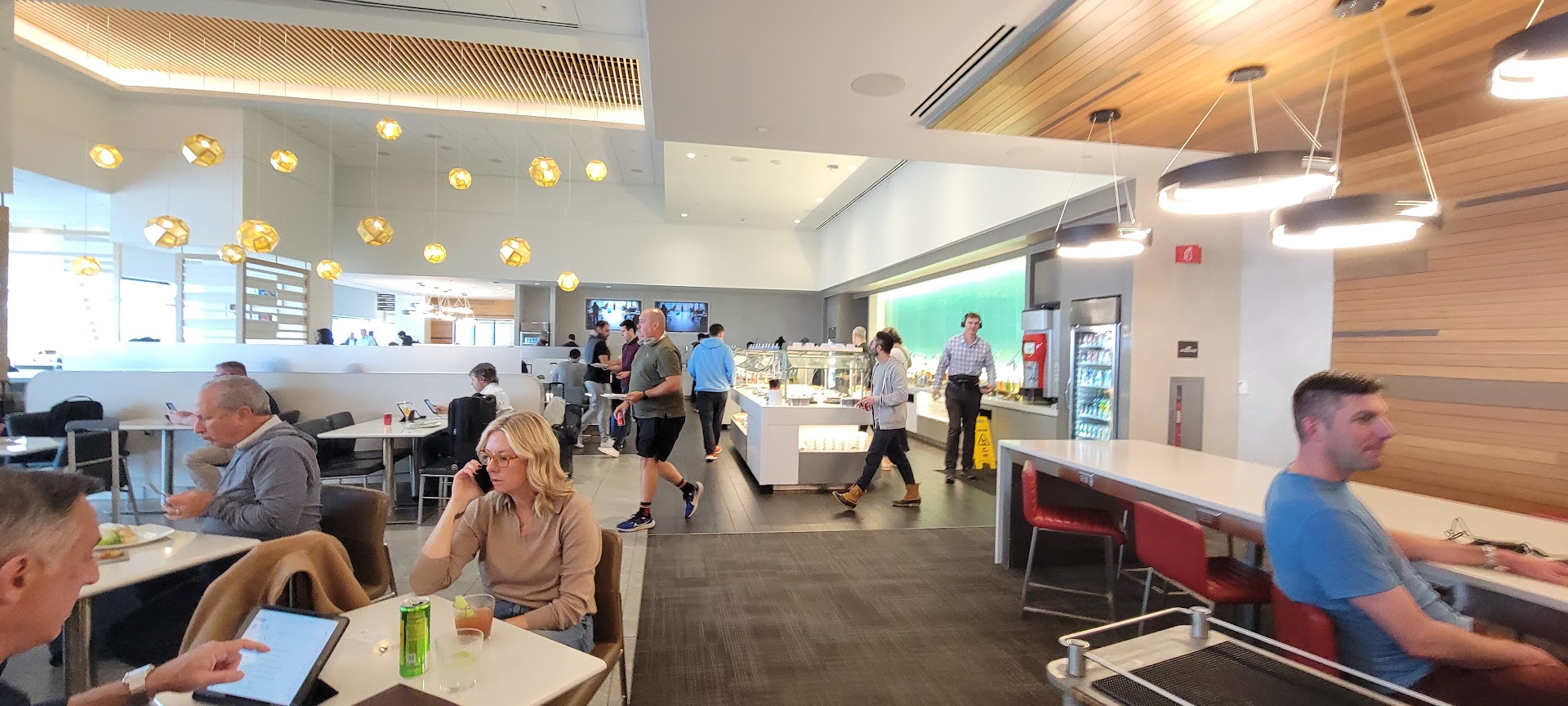
DFW Flagship Lounge
It’s possible that I am wrong. I was at least somewhat wrong about former American Airlines President and now United CEO Scott Kirby. But Robert Isom has always presented himself as believing,
- That the food tastes better and service seems friendlier when flights are on-time. The focus needs to be on an on-time operation, and that’s enough rather than being the baseline.
- That the most profitable business model belongs to Spirit and Frontier, and that what customers want is low fares. They can’t allow themselves to be outmaneuvered by ultra-low cost carriers.
- That airlines are a low margin business and they win by controlling costs.
American Airlines is relying on executives who have succeeded with current management and with the current framework to drive a premium and customer focus. That they aren’t bringing in senior outsiders with a history of success in premium marketing and customer experience to shake things up leads me to be skeptical that they will change the culture and decision-making at the airline, rather than dressing things up differently. I would love to be wrong.
How American Can Become Premium Again
American is a high cost airline that’s been trying to be a low cost provider of seats. But a premium airline isn’t fundamentally a provider of seats at all. This is something that Delta figured out over a decade ago, trying to reposition themselves away from being thought of as an airline and more of a brand. That’s helped them gain market share in New York and Los Angeles and gain wallet share for their co-brand – which is why they now claim that nearly 1% of GDP runs across their American Express cards.
Premium starts with the customer and the viewpoint of the customer needs to permeate every decision and policy. For too many years American Airlines made short-sighted decisions meant to nudge customers to be lower cost or higher revenue, but the strategy was to inconvenience customers.
- Made it harder to find seats to change flights on the day of travel, requiring that customers fly the exact same routing as their original ticket. There’s no value to the customer of having the best domestic hubs if you don’t let customers use them! And some cities don’t have multiple flights to each hub, meaning they couldn’t choose different flights even though American offered plenty of itineraries where they’re going throughout the day.
- Made it harder to check bags, requiring that passengers flying on separate tickets (even when booked inside the same reservation!) check their bags only as far as the first ticket get them – then leave security (and sometimes go through immigration) to collect bags and re-check them. This meant American wouldn’t have to split checked bag fees, and encouraged customers to book all travel on a single ticket (re-faring to more expensive tickets if plans changed at the last minute). But it’s a huge pain to customers.
If they booked award travel on Etihad, but there wasn’t award space on an American flight to connect to the Etihad itinerary and a customer spent hundreds of extra dollars on American to get there then American wouldn’t through-check bags.
- Refused to let most customers add themselves to a standby list at the gate – requiring them to use self-serve tools (website, app) at least 45 minutes prior to flight. No more running up to the gate to catch an earlier flight. If a flight was boarding but had plenty of seats left, the customer would be left behind – because it was within 45 minutes of departure. (Standby is no longer allowed when checking a bag, except if you have status. But self-serve systems don’t support standby with checked bags, so Gold and Platinum members can’t stand by with checked bags even though they are entitled to.)
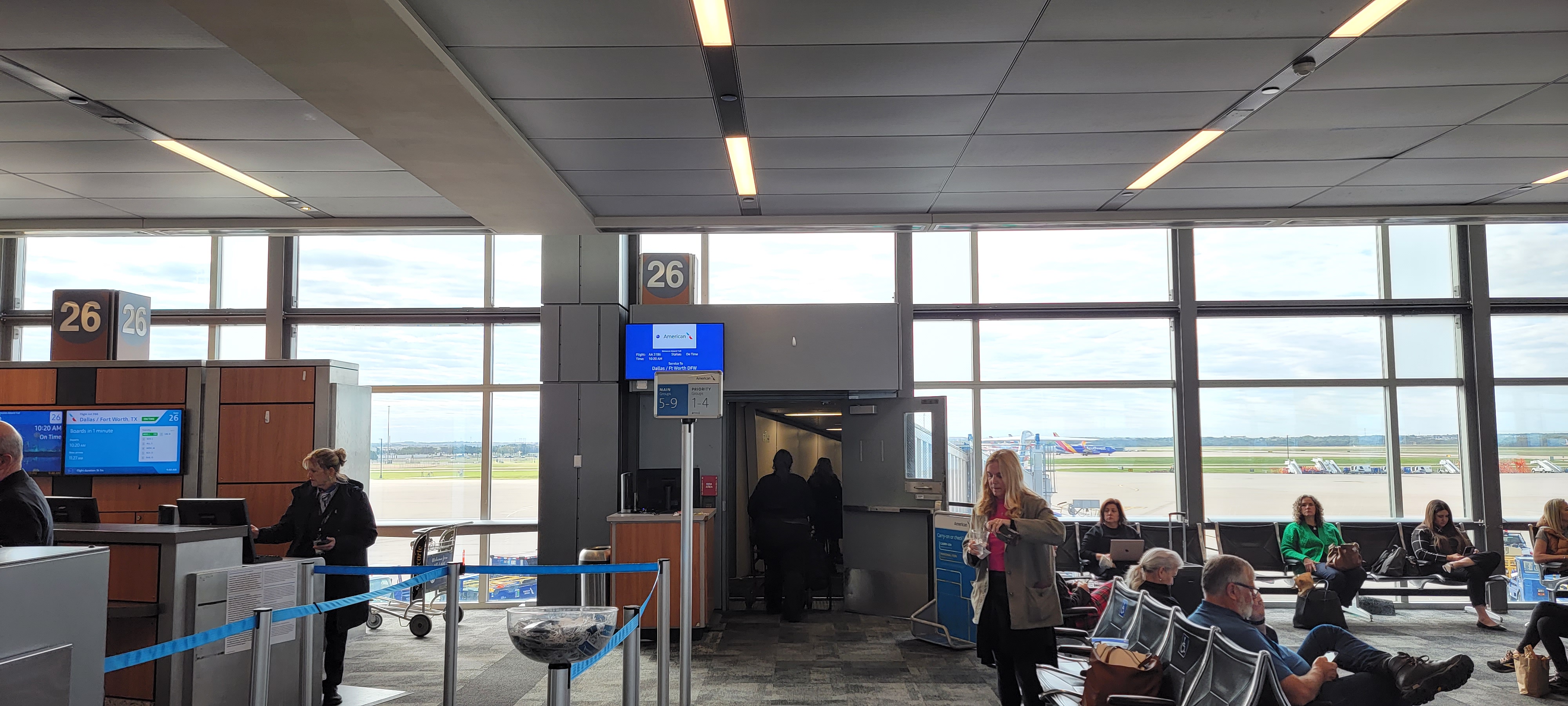
None of these are premium experiences. They don’t have anything to do with investment in product or first class travel. They are entirely about how an airline thinks about problems – is the customer’s journey the starting point?
There are basically two ways to offer a premium experience. One is to out-spend the competition, think Etihad circa 2013 when passengers on business class redemption tickets booked by partner airlines were entitled to a car service on both ends of their journey. That’s a recipe for losing money.
Make no mistake you need to invest more than American Airlines does today. They need to make capital expenditures – offering wireless seatback entertainment screens; reconfiguring planes to offer more extra legroom coach seats as well as the plan for more first class; refreshing club lounges especially in places like Charlotte and Philadelphia (and accelerating the transition to the current and quite beautiful aesthetic represented by Denver, Newark and Washington National E Concourse). They need to invest more in wine, because they’re at a 7-11 budget today offering bottles that retail for at times 75% less than what competitors spend.
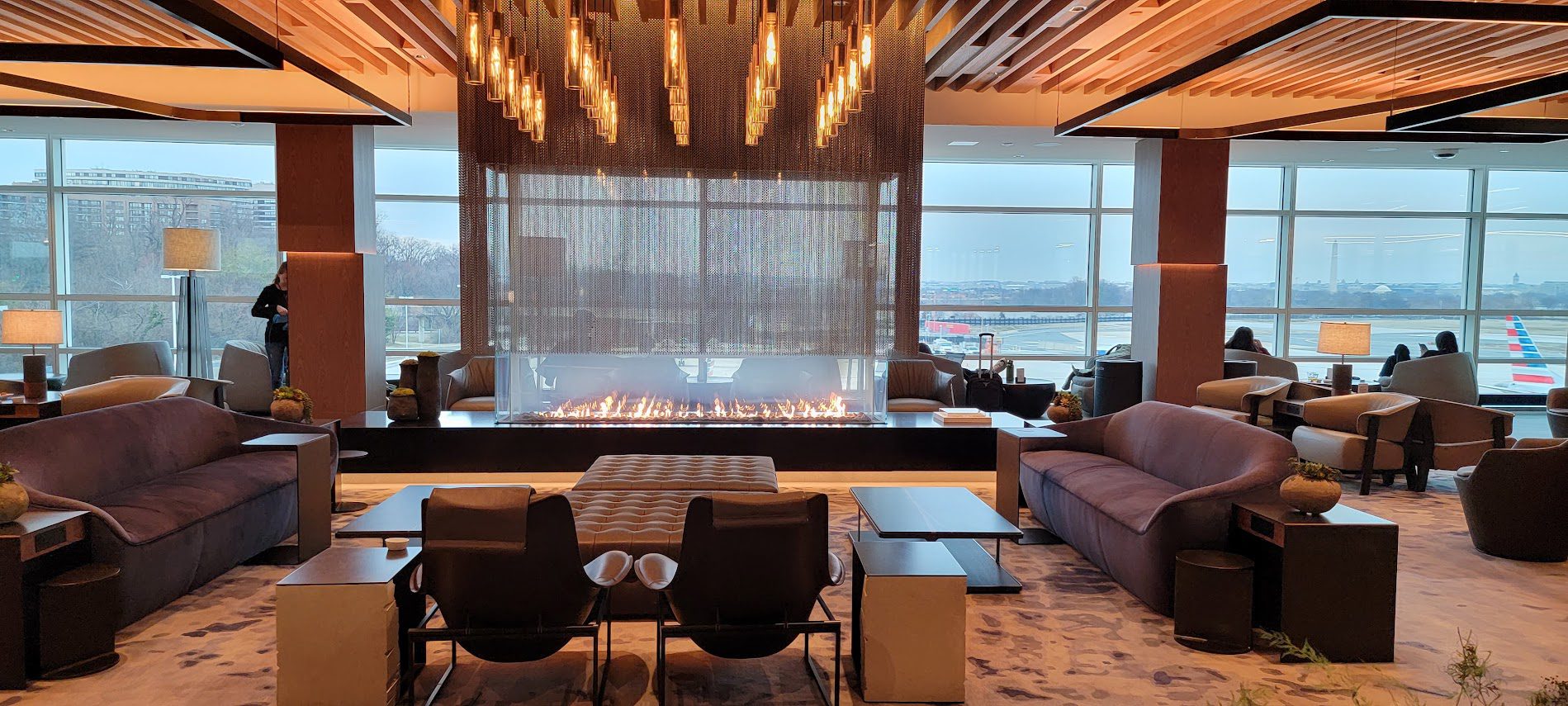
American Airlines Admirals Club, Washington National E Concourse
Fundamentally, though, it’s a mindset about getting the details right, getting the most for each dollar spent, not ‘taping it out’ where American didn’t bother building a cabin mockup of its new domestic product before rolling it out across the fleet – a LOPA and seats checked boxes, they cared about number of seats and didn’t focus on how the layout would work for passengers and crew in practice. That wound up more expensive because they had to retrofit planes to fix problems created by their retrofit.
I’m not sure that mindset can happen by reshuffling executives. That’s not the talent they’ve recruited and cultivated. The people that didn’t value these things will have a hard time credibly demonstrating that a new way of doing things is real – and will remain so in 5 and 10 years. So you have to bring in senior spokespeople for the effort who give it credibility.
Then make symbolic investments, like the return of screens or like United did with coffee and coach snacks. The idea is to visibly demonstrate a break from the past so that everyone sees it as a new day and that it’s time to behave in a different way, and deliver a different level of service.
Cabin crew have long been confused whether they’re supposed to be delivering premium or cut-rate service because of mixed messages from management. That needs to change.


If AA was serious about pivoting towards premium they would have moved and done this a long a time ago. It’s too late the damage has been done. Make sure Robert Isom is let go
The first sign of recognizing that you need to improve is realizing where you have failed.
Oscar Munoz was that person for whom the light when on at United; UA touted its superlatives for years – such as round the world flights, first to fly to all 50 seats etc – but didn’t deliver a US industry beating product for customers or industry leading financials for stockholders.
Scott Kirby and his team that left AA all realized what didn’t work during the tenures at AA and its predecessor airlines; they found even more things to fix at UA and are spending enormously to do it.
They ALL are still chasing DL. Despite the CrowdStrike issue, DL still led the industry in most operational metrics and nearly all financial metrics.
AA has to admit what is wrong – but even if they went on a spending spree as big as UA has over the past 10 years, they will likely still not regain what they lost and UA still trails DL even though they are paying many of their employees less than DL’s employees.
DL’s transformation has been in process for 15 years. As much as UA thinks they can catch up to DL, DL has a whole lot more it can and is doing to put even more distance between itself and the competition.
There is nothing that AA is doing that DL didn’t do years ago and UA has decided to copy DL in doing.
The US is a very big air travel market but it is hard to believe that AA can now flip the switch and deliver what it said hasn’t mattered for 15 years.
I agree with everything except seat back entertainment. I’m happy to see that it is gone. We all have phones and update them regularly. If they offer consistent streaming service than IFE is not needed. But who knows. Just seems like a waste.
Good summary and suggestions. I’ve followed you for years as an AA flyer out of DCA. Hoping AA would shake off its legacy of lousy CEOs I really dislike Parker. Flew pd 1st on American West years ago and was not impressed.
I still find value with AA but it’s a struggle
BTW I got a chauffeur ride home from IAD on an EY 1st Award back in the Day 😉
They have a loooooong way to go. Since AA cancelled its PHX-LHR flight to seasonal, I have been holding my nose and flying BA’s A350-1000 business class service on this route. Not only are the BA ‘planes new versus geriatric 777-200s (20 yrs +) but the service, food and wines are vastly superior.
All BA has to do now is stop their FA’s locking out the fwd lav (one of three in a 56-seat cabin) about half way through the flight so they can use it themselves for the rest of the flight. (They lock the door, so the indicator in the cabin shows red or occupied, but close a paper towel in the door to show their colleagues it’s vacant).
Hi I’m Tim Doneth. I feel like the need to compare Delta and United in every single article, because I feel threatened by United Airlines and I worship Delta at every single opportunity I can. Thank you!
Gary Leff — In yet another post about American Airlines, so-called ‘pivot’ to premium, on lounges, you did not include what the airline has already done at JFK T8 with the Soho and Chelsea lounges, which are an elevated experience, even above the typical Flagships (at say, MIA, etc.) Those two examples of AA at JFK do actually compete with DeltaOne (which is still best in the US today, and United Polaris. Hope you get to experience them someday so you can include it in this discussion as well.
Gary, American Airlines should hire you. Your ideas are solid.
@1990 good point on the JFK lounges; but at the same time I feel like they are one offs because they are joint lounges with BA. (Meaning… I give a lot more credit to BA than AA when it comes to these lounges.). Meanwhile the Greenwich Lounge is just okay.
Sadly…their culture won’t let it happen. Even having the world by the bum, there isn’t rnough plasma to do the needed bloodwash.
Would anyone in this group travel AA, or any American carrier, internationally to Asia or the middel east?
There simply is no comparisn.
How can they offer a service while cabin delivery is essentially in complete control of beligerant union-types?
During a cabin crew strike by its unionized staff a few years ago BA “wet leased” planes from Qatar.
Service ratings went from “BA=bloody awful” to absolutely superb. Only the people were different. They were simply better people.
Maybe American could do the same thig. Fire the lazy goodfornothing union lackeys who hate their jobs and wet lease from a more professional culture.
Wine and food needs much improvement on board – intl and transcon premium cabin wine selections are dreadful.
Bring real protein back to the apps on the domestic first flights – like the shrimp. And offer more exclusive preorder options like UA is doing. The crab cakes and steak are great there.
@1990 – The Chelsea lounge is a downgrade compared to Flagship First Dining that was there before, and Greenwich is basically Flagship not sure how it’s elevated? I have experienced those (as well as Soho) and of course Polaris lounges at EWR, IAH, SFO, etc
After a few years hanging out in the ck lounge on flyer talk and given my own personal experience, aa service, from time to time is really great when you get lucky and interact with the right staff, but on a whole is going down and down. I’m not sure what they can do to reverse the trend.
it is very much appropriate to compare AA, DL and UA as Gary has done.
They are the 3 most closely matched airlines in the world and AA’s plans to turn itself around – again – are very much driven by the success that DL has had for the past 15 years and UA has found over the past couple of years copying DL’s strategies.
“Cabin crew have long been confused whether they’re supposed to be delivering premium or cut-rate service because of mixed messages from management. That needs to change.”
Absolutely agree. In the last 6 months getting a preflight beverage has dropped to about 30%-40%, and worse on the regionals.
One thing that *seems* to be getting better is that for at least this EP, I now get someone on the phone in a few minutes. NOTHING is more frustrating than buying 1st class, the flight is significantly delayed, there are 40 people in the airport “Premium” line ahead of you, and when you call AA there is a 2 hour wait time because “They are helping other customers.” Yes, these are first world problems BUT you are paying *more*, so I think it’s reasonable to get better service because you are indeed paying more than trying to fly as cheaply as possible (like I first did as a student- and happily so to save money!- but now as an adult, my time is worth much, much more.)
And other things are easy to do- like addressing 1st class passengers by their name throughout the flight. The best FAs do this, but it’s still rare. And guess what? It’s FREE. 🙂
Better YET, have a simple CRM (Customer Relationship Management) app for FA’s to take notes on the passengers. Things like me would be, “Likes Pineapple Truly hard seltzer, just the can only” and soft touches like “Has Four adult children, recent empty nester, now traveling more.”. I’m an IT guy and it can’t be that hard to make something simple.
I’m also at a point that I am looking (and buying 1st class) at other airlines because of the service difference. Delta comes to mind as well as JetBlue Mint’s product, which is pretty good.
American Airlines’ so-called “premium pivot” is doomed to fail under the current management team, not because the idea itself lacks merit, but because the airline’s leadership has repeatedly demonstrated an inability (or outright unwillingness) to execute on premium service. The fundamental problem is that American has long prioritized cost-cutting over customer experience, and a strategy that demands an elevated product and service standard cannot be successful when led by executives who have spent years hollowing out the very aspects of the airline that once made it competitive. Simply put, you cannot build a premium airline with a budget airline mindset.
For years, American has chased short-term financial efficiencies at the expense of long-term customer loyalty. It has systematically gutted inflight catering, downgraded premium cabins on domestic aircraft, and degraded the experience at nearly every touchpoint. The argument that the airline is now embracing premium customers rings hollow when the same leadership team has spent years dismantling the very elements that would have supported such a shift. Why should customers believe in this pivot when their past experiences tell them otherwise?
Moreover, American’s labor relations remain a major obstacle. A premium airline cannot succeed without a frontline workforce that is motivated, empowered, and committed to delivering high-end service. Yet American’s management has historically fostered a culture of hostility rather than partnership with employees. Flight attendants, pilots, and ground staff have been demoralized by stagnant contracts, understaffing, and operational chaos. A new seat or a fancy meal means nothing if the employees tasked with delivering the experience feel disrespected, overworked, or indifferent to the airline’s success. The best airlines in the world (SQ, QR and even to some extent DL) understand that service culture drives premium experiences. American, under its current leadership, does not.
Further, American’s executives have a track record of making bold proclamations that ultimately amount to nothing. How many times have we heard about a renewed focus on quality, only to see the airline double down on cost-cutting instead? The removal of premium Flagship First on international flights is a prime example of this contradiction. While Delta is aggressively expanding its premium offerings and investing in consistent service, American is playing catch-up with an outdated and disjointed strategy.
Real change requires more than marketing buzzwords. It requires a leadership team with the vision, operational competence, and long-term commitment to excellence that American’s current executives have failed to demonstrate. If this pivot is to have any real chance of success, it must begin with new leadership that values product, service, and customer loyalty over quarterly cost reductions. Otherwise, this so-called “blueprint for success” will be nothing more than another broken promise in American Airlines’ long history of failed pivots.
The seatback screens are essential IMHO. It’s brand perception. It’s one of the first things a passenger notices when boarding the aircraft. If you don’t like them, don’t use them. You can turn them off, and they can still offer the streaming service for virtually no added cost. And the modern systems don’t require any equipment boxes under the seats.
DL has long understood this and UA has recently seen the glow as well.
Looks like “Premium” only extends to Flagship Business (first going away) and FL lounges. Everything else is pretty much as is. If Frontier ever wanted to open lounges, they just need to visit the PHX and CLT lounges to get some ideas.
I agree with most of what you said Gary…I do think there is a premium market and AA fails to attract much of that business. They equate, for instance, a flight from CLT – Maui that connects in AZ or LA on basic domestic 321 service on both segments to CLT-DFW to connect on 777 service…in FIRST. The prices are the same and the consumer is often left with the only choice which is to book the first day the ‘better’ arrangements become available. Instead of realizing there is an untapped premium market on “THAT” flight (and others of course) vs. the many where that market is really not there…they treat all flights as if the market isn’t there. The problem lies in their fleet which is entirely untuned to the premium market…how can AA compete on ultra long haul for instance LA to Sydney when Qantas is running a 380-800 with al it can offer in terms of space and premium product offerings and AA is running what looks to be a glorified 737 when the two sit side by side. The more I speak to those who in the market to buy a premium ticket, the more I realize this is true. AA runs their premium department like a Hampton Inn offering a few suites whereas other airlines run theirs like a Curio Collection hotel where the experience the customer requires is made possible because of the ‘facility’ provided. This doesn’t mean the 787 fleet has no place…it does, but this airline needs a far more diverse fleet of aircraft to even think of competing with Emirates, BA, Singapore and all the others.
I agree that the small details that often don’t cost much or cost nothing at all are part of the experience. Yeah, being on-time is key, a wine that actually is paired or is just a bit more costly makes the meal…the small details that make the customer feel ‘hey someone knows what they are doing’. AA doesn’t offer any meals in FIRST on flights for instance Chicago to New Orleans…really…at one point CLT-BOS has a small meal. Main Cabin Extra actually is preferred to FIRST in my opinion because you get more leg room in an exit row…sure a little less width but what do you really get for the extra $$ or miles spent?
What I do like is the meal selection option in FIRST …when you can manage to find a flight where a hot meal is served!!. There are many choices and that is good, but the quality must be paid more attention to since they’ve been hit and miss…and things like hot bread service, warm nuts, drinks before takeoff…all seem to be hit or miss with little explanation as to why (ran out of nuts, short on flour in the city, who knows?). The same issue applies to Main Cabin Extra…where food used to always be available on somewhat longer flights, now the flight has to be transcon and the cheese and fruit platter is ONLY available for three hours in the morning if you are lucky and they put two on board. The small details…
Very well said.
American’s management can utilize one simple metric to determine whether an item deserves consideration: ask out loud “What will our customers think about this?”.
IMO, until they can improve the AAdvantage program, they’re unlikely to return to a significantly competitive level. People used to go out of their way to fly AA because of the AAdvantage program. That has changed. Period. Full stop.
If multiple airlines get me from point A to point B, on dates/times that work for my needs and both offer relatively the same hard and soft products, I choose the one that’s going to be the most rewarding for me. 10 years ago, I’d go out of my way to choose AA 9 out of 10 times, even if it meant paying slightly more, connecting or going at a less desirable time. Nowadays, I often choose to book elsewhere as my loyalty to AA has waned. Why go out of my way to fly AA? Comp upgrades are near existent. SWUs are near impossible to confirm in advance. The most desirable premium international award seats are significantly harder to get (and more expensive) than years ago (not to mention the fact that AA’s international destinations pale in comparison to its competitors, I’ve had enough of LHR).
In the last 12 months, not only have i moved nearly 50% off my domestic paid travel from AA to UA, but I’ve opened up 3 new credit cards in other non-AAdvantage ecosystems, issued long-haul rewards tickets on *A (thanks to AC and UA) and SkyTeam (thanks to FlyingBlue) carriers and have significantly reduced my spend on AA Citi cards.
Isom is an idiot who doesn’t care about customers or employees. He’s proven it again and again. Don’t believe anything he says. AA culture will not change while he collects his bonuses and inflated salary for destroying AA. He needs gone already. Maybe the next CEO can salvage the customer experience, or maybe it will be too late. Time will tell.
Apparently, very few people who comment on airline blogs are concerned with safety. I guess its taken for granted. Ask the 67 people who were killed recently. Would they say that safety isn’t important. It’s not like I think that the customer experience on American can’t be improved. It obviously can. But I have to ask what’s really more important: getting passengers and cargo to their destinations safely or providing seat-back TV sets?
Once American begins to invest in improving its customer experience, the same people who are now complaining about the lack of seat-back TVs will start whining that the airline isn’t doing enough to reduce its debt. It’s almost as if the critics want to be critical for the sake of being critical – and want to hate the airline’s management. Forget the fact that they engage in double standards – criticizing the current management for keeping costs down and reducing debt while conveniently ignoring the actions of a former CEO who famously wanted to remove an olive from the salads to cut costs. News flash: Costs are relatively controllable. Generating revenue isn’t. Apparently, the only thing that will truly make American’s critics happy will be to see the airline liquidated.
“The first step in solving any problem is recognizing there is one.” (h/t Aaron Sorkin)
American is not the greatest airline in the country anymore.
I’m not convinced yet, but I suppose my above quote shows there should at least be some hope.
Gary, a nice long list of wishful thinking on your part – but these appointments are bean-counters with the primary objective to cut costs. Don’t believe the marketing nonsense about “customer experience”
That accident wasn’t American’s fault. The helicopter was a few hundred feet higher than supposed to be and flew right into it.
As far as premium product goes they are failing. Lounges kind of suck and I rarely get a pre departure drink other than water or juice.
They just have the most flights out of my airport
LOL
No, the market hasn’t “shifted sharply to product and customer service”: it’s always been that way!!
What has changed is that the difference in quality between AA and DL (and now UA) has increased, starting from the extremely visible lack of TV screens, and their halo effect even on people who don’t use them (or rather, has them on the flight map) on one particular flight.
What an awful management. They are the reason for the problem, and yet blame it to customers. As If it wasn’t their job to make sure that they deliver what customers want!
@DesertGhost – you have a very good point. The airline did get into too much debt in order to meet management targets that unleashed their outlandish executive pay (the guy who orchestrated the decline of the company, and cost shareholders billions, Doug Parker, was paid way over $100 million).
Bankruptcy is probably the only way out of this hole. Basically watchers have to wait until the next recession for a reset.
Before then, the company is in a strategic straightjacket, with no capital to invest in product and not enough unit revenue to cover costs due to having a bad product offering.
Why on Earth doesn’t the AAL Board get a new Exec team?… There is literally no downside to doing so at this point, and to start fresh… Unbelievable.
First, AA has done things wrong for quite awhile. This is all driven by stockholders and executives being greedy.
Second The airlines needs to set a time limit that when they introduce a new product that it is rolled out within a maximum limit like 6 months.
Third, Provide the employees within training in person, not in an online lesson, hands on works better when introducing a new product.
Fourth, All aircraft need a new interior look, and new uniforms for the employees. Also, Have a grooming checks, and ask employees for their input. If the employee is negative then let the employee go. The aircraft are filthy with worn out carpets and placarded items. Fix these items, by having the night shift mechanics back.
Fifth, More options means better happier customers. Get rid of the stale pretzels and put a brand name, rotate food selections every three months. No one wants to eat the same meals for 6 months.
Bring back the inflight interment screens, it’s interpreted to me on world class airlines, weather the customer uses them or not.
Sixth, You have to spend fifty cents to make a dollar. Replace management with people who have a vision.
They need to bring back meals on shorter flights. I’m tired of flying NYC>ORD without a meal like they used to have.
Sadly, I suspect this “pivot” is mostly about finding ways to get us to pay more for the existing level of service. Maybe we’re headed for “unbundling” of premium services.
I was a loyal AA customer for decades, but years of downgrades have destroyed any sense of loyalty I felt to the airline. These days I fly whoever offers the best product at the most reasonable price, and that may not always be the cheapest fare. For example, I chose JetBlue on an upcoming trip to Las Vegas because they offered a non-stop flight AND their excellent Mint product for a price that was comparable to many of the one-stop AA F routings I looked at.
I usually fly AA enough to make Platinum Pro without too much effort, but I’m done chasing Executive Platinum. As others have said, the return on investment just isn’t worth it anymore. Why reward an airline that makes so little effort to value its premium customers? I’m not a super wealthy guy, but I’m generally willing to spend the money to fly First or Business if the product is a good one. I’d be happy to give AA my business if they put actual effort into delivering a premium product, but I’m not holding my breath.
AA needs to have a customer experience team that regularly flies incognito to evaluate the quality of their products. What they’re doing now isn’t working. I really do hope they turn it around.
They can focus on “Premium” but they should focus on seat comfort. At the end of the day, the seat’s comfort is the main factor that passengers are impacted by. When other airlines have more pitch and width in the economy, you are doing something wrong.
If they want to be premium, they need to get rid of all this uneducated Trash passengers they fly around….. Look up
Excellent summary of the many “little” things they have, over the years, repelled high spending customers away from AA.
I am surprised, however, that your first mention of staff/crew is in the final paragraph. The work ethic and customer focus of this group will be make-or-break for any attempt to turn things around. I’m not confident AA has the cajones to take on that labor group.
Agree with the assessment: moving from competing on price to customer experience is a deep cultural change!
And clearly Isom isn’t the one to deliver that when he says “pivot to premium” – this type of change is not a pivot, it takes many years….
I actually believe AA when they say this. Their cutbacks on First Class and MCE were back when they were mostly giving those seats away as free upgrades. Now that airlines are better at actually monetizing those seats, it makes sense to make them competitive.
However, since Murphy’s Law effects AA’s strategies more than any other entity in the universe, this means that demand for premium airfare is about to plummet.
I would argue, it’s always been about “product and customer service”. Why any business leader thinks cutting quality and service is going be successful is foolish short term thinking.
Too late!!
I don’t think that they realize how hard it is to get back customers especially since this “upgrade” is just in the talking stages
Personally, after almost 40 years, i don’t fly them internationally (foreign carriers are much better) and only fly them domestically when it suits me – not like in the past when i would go our of my way
Very sad to watch a once great airline fall to where they are today
As a longtime Executive Platinum, for years I’ve often chosen connecting flights with AA over nonstops with other carriers in order to maintain status. But one carrier often enticed me to overlook my EXP priorities: Alaska.
Now that Alaska is a member of the OneWorld program, I consistently choose Alaska over AA when all things are roughly equal with flying time and price — Alaska now represents almost 50% of my domestic itineraries (AA is about the same, with Delta and United picking up scattered leftovers).
For domestic flights, Alaska consistently beats the big three in terms of service, comfort and, especially, food.
An insightful and comprehensive breakdown of American Airlines’ premium strategy. It’s fascinating to see how they’re positioning themselves for the future, and the challenges are clearly laid out. This will be crucial for frequent flyers to understand what’s ahead.
When airline management focuses on D0, from the top down, not on A0, not even on A15, every cabin and seat is late, and nothing about it is premium. A management that has no premium focus should be replaced, from the top down.
Does anyone realize that if you book on American through AMEX , they are putting a 15% surcharge on the tickets in comparison to Expedia or AA.com.
It’s disgusting and unethical. Not a good way to get premium customers.
I had an interesting opportunity to compare service levels flying ORD to DOH last month. A late connecting flight and a helpful gate agent with phone back up got us switched to Qatar Airways for ORD – DOH. Qatar Airways was glorious, with spacious square seating in Business, lobster as a main course (delicious) and improved everything from pajamas to kit to attentive FAs. Flying home DOH – PHL on AA was a big let down for a 14 hour flight, with a modest domestic meal on departure and breakfast two hours out. Why spend money on AA when codeshare QR provides a superior service?
It isn’t going to happen. Since roughly before the USA merger AA has been continuously declining at a rapid rate and most of the decent employees have given up trying. I feel sorry for the few that do try. The lack of caring and any sense of urgency about anything is so far ingrained it has passed the point of any change. It is a mess and it is what we have learned to sadly accept.